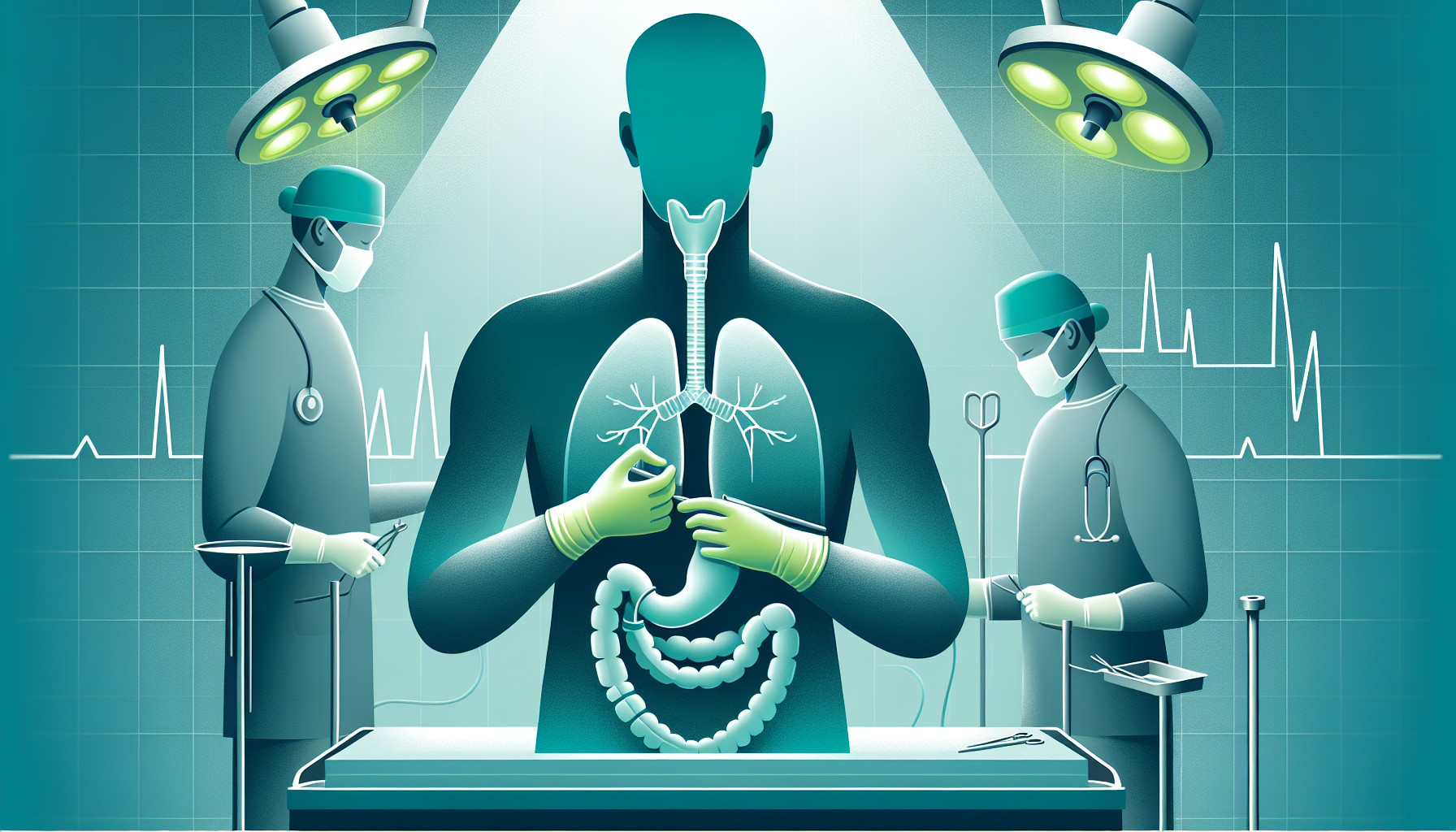Our Summary
This research paper is about a study that was conducted to evaluate a surgical technique called colonic interposition, which is used as an alternative method to reconstruct the esophagus when the stomach cannot be used due to previous surgery, extensive tumor involvement, or complications from a previous surgery. The researchers specifically focused on the use of a tool called Indocyanine Green Fluorescence Angiography (ICG-FA) to help visualize blood flow in the tissues during surgery.
The study included patients who had this surgery between 2015 and 2021. Since 2018, ICG-FA has been used during the surgery. The results showed that among the patients who had the ICG-FA-guided surgery, 20% experienced a common surgical complication called anastomotic leakage (AL), while 31% of those who did not have the ICG-FA-guided surgery experienced AL.
The researchers concluded that using ICG-FA is a safe and practical technique to assess blood flow during colonic interposition surgeries. It also proved useful in decision-making during the surgery, leading to a change in surgical approach in about 20% of the cases. However, the role of ICG-FA in preventing complications like AL still needs to be further explored.
FAQs
- What is colonic interposition and why is it used in esophageal reconstruction?
- What is Indocyanine Green Fluorescence Angiography (ICG-FA) and how is it used in colonic interposition surgeries?
- Did the use of ICG-FA during colonic interposition surgeries impact the rate of complications like anastomotic leakage (AL)?
Doctor’s Tip
A helpful tip a doctor might tell a patient about esophagectomy is to follow a strict post-operative diet plan to ensure proper healing and reduce the risk of complications such as anastomotic leakage. This may include avoiding certain foods that can irritate the surgical site, eating smaller, more frequent meals, and staying hydrated. It is also important to follow up with your healthcare provider regularly for monitoring and support during the recovery process.
Suitable For
Esophagectomy is typically recommended for patients with conditions such as esophageal cancer, Barrett’s esophagus with high-grade dysplasia, severe esophageal strictures or narrowing, or other benign or malignant conditions that affect the esophagus and cannot be treated effectively with other methods such as medication or endoscopic therapy.
Specific types of patients who may be recommended for esophagectomy include those with:
Esophageal cancer: Patients with early-stage esophageal cancer may undergo esophagectomy as a curative treatment option. For more advanced cases, esophagectomy may be used in combination with other treatments such as chemotherapy or radiation therapy.
Barrett’s esophagus with high-grade dysplasia: Patients with Barrett’s esophagus, a condition in which the lining of the esophagus is damaged by chronic acid reflux, may develop high-grade dysplasia, a precancerous condition. Esophagectomy may be recommended to remove the damaged tissue and reduce the risk of developing esophageal cancer.
Severe esophageal strictures or narrowing: Patients with severe narrowing of the esophagus that causes difficulty swallowing or other symptoms may require esophagectomy to remove the affected portion of the esophagus and restore normal function.
Other benign or malignant conditions: Esophagectomy may also be recommended for patients with other conditions affecting the esophagus, such as esophageal diverticula (pouches that form in the esophagus) or esophageal perforation (tear in the esophageal wall). In some cases, esophagectomy may be the best treatment option to address these conditions.
Overall, the decision to recommend esophagectomy for a patient is based on factors such as the type and stage of the condition, the patient’s overall health and ability to tolerate surgery, and the potential benefits and risks of the procedure. It is important for patients to discuss their treatment options with their healthcare provider to determine the most appropriate course of action for their individual situation.
Timeline
Before esophagectomy:
- Patient undergoes preoperative evaluations and tests to determine their overall health and suitability for surgery.
- Patient meets with the surgical team to discuss the procedure, risks, and potential outcomes.
- Patient may undergo chemotherapy or radiation therapy to shrink the tumor before surgery.
- Patient follows a special diet and may need to stop certain medications before surgery.
- Patient undergoes the esophagectomy procedure, which involves removing a portion of the esophagus and sometimes part of the stomach.
After esophagectomy:
- Patient is monitored closely in the intensive care unit (ICU) immediately after surgery.
- Patient may have a nasogastric tube to help drain fluids from the stomach.
- Patient gradually starts to consume clear liquids and then progresses to a soft diet.
- Patient undergoes physical therapy to regain strength and mobility.
- Patient may experience complications such as anastomotic leakage, pneumonia, or infection, which require additional treatment.
- Patient is discharged from the hospital and continues to follow up with their surgical team for monitoring and follow-up care.
What to Ask Your Doctor
How will the decision to undergo an esophagectomy be made, and what are the reasons for choosing colonic interposition as the reconstructive technique?
What are the potential risks and complications associated with an esophagectomy, particularly with colonic interposition?
How is Indocyanine Green Fluorescence Angiography (ICG-FA) used during the surgery, and how does it help visualize blood flow in the tissues?
What are the potential benefits of using ICG-FA during the surgery, and how does it impact decision-making during the procedure?
What is the success rate of using ICG-FA in preventing complications like anastomotic leakage (AL), and how does it compare to surgeries without ICG-FA guidance?
Are there any long-term implications or considerations to keep in mind after undergoing an esophagectomy with colonic interposition and ICG-FA guidance?
What is the follow-up care plan after the surgery, and what signs or symptoms should I watch out for that may indicate a complication or problem post-surgery?
Are there any lifestyle changes or dietary restrictions I need to adhere to after the surgery, and how can I best support my recovery and healing process?
Reference
Authors: Joosten JJ, Gisbertz SS, Heineman DJ, Daams F, Eshuis WJ, van Berge Henegouwen MI. Journal: Dis Esophagus. 2023 Apr 29;36(5):doac076. doi: 10.1093/dote/doac076. PMID: 36309805
